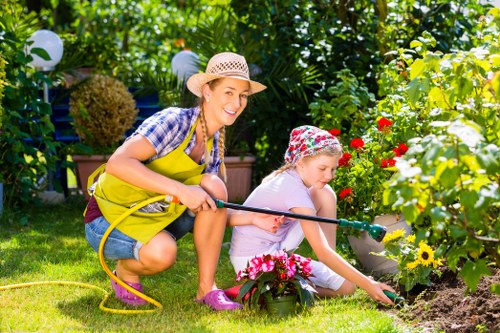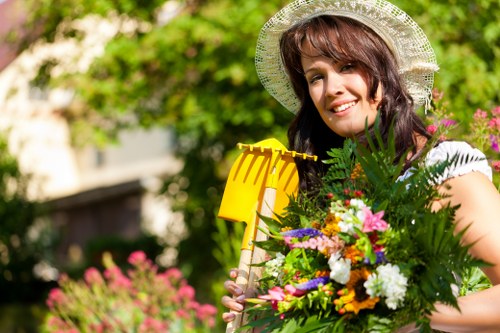Garden Fence Installation in Grass Cutting
Enhancing Your Garden’s Appeal and Functionality

Installing a garden fence is a transformative project that not only elevates the aesthetic appeal of your outdoor space but also enhances its functionality. Whether you're looking to create a private sanctuary, define boundaries, or protect your garden from unwanted intruders, a well-installed fence serves multiple purposes.
One of the key benefits of a garden fence is the added privacy it provides. By strategically placing a fence around your garden, you can create a secluded area where you can relax, entertain guests, or simply enjoy the beauty of your plants without the disturbance from passersby.
Moreover, a garden fence acts as a barrier against animals and pests. Birds, rabbits, and other small creatures may wreak havoc on your plants, but a sturdy fence can keep them at bay, ensuring your garden remains lush and thriving.
Types of Garden Fences

When it comes to selecting the right fence for your garden, there are several options to consider, each with its unique advantages. Here are some popular types of garden fences:
- Wooden Fences: Classic and versatile, wooden fences offer a natural look that blends seamlessly with any garden landscape.
- Metal Fences: Durable and low-maintenance, metal fences are ideal for those seeking longevity and security.
- Vinyl Fences: These fences are resistant to weather conditions and require minimal upkeep, making them a practical choice.
- Wrought Iron Fences: Known for their ornate designs, wrought iron fences add a touch of elegance and sophistication to any garden.
Selecting the right type of fence depends on your specific needs, budget, and the overall design of your garden. It's essential to weigh the pros and cons of each material to make an informed decision.
Additionally, consider the height and style of the fence. Taller fences provide more privacy, while decorative styles can serve as a focal point in your garden design.
Preparing for Fence Installation

Proper preparation is crucial for a successful garden fence installation. Here are the steps you should follow to ensure a smooth process:
- Assess Your Garden: Examine the layout of your garden to determine the best location for the fence. Consider factors such as sunlight, existing plantings, and access points.
- Check Local Regulations: Before installation, consult your local building codes and homeowner association guidelines to ensure compliance with height restrictions and other regulations.
- Choose the Right Materials: Based on your assessment, select materials that are suitable for your garden's climate and your aesthetic preferences.
- Gather Tools and Supplies: Ensure you have all necessary tools, including post hole diggers, levels, concrete, and measuring tapes, to facilitate the installation process.
By following these preparatory steps, you can avoid common pitfalls and ensure that your fence is both functional and visually appealing.
Don't forget to plan for grass cutting around the fence. Regular maintenance not only keeps your garden looking neat but also prevents grass from obstructing fence posts and seams.
Installation Process

The installation of a garden fence involves several key steps:
1. Marking the Fence Line
Using stakes and a string line, mark the exact path where the fence will be installed. This ensures straightness and uniformity throughout the project.
2. Setting the Posts
Digging post holes is the next critical step. The depth and spacing of the holes should align with the type of fence being installed. Typically, holes are dug two feet deep and spaced about eight feet apart.
3. Securing the Fence Panels
Once the posts are set and the concrete has cured, attach the fence panels securely. Ensure that each panel is level and properly aligned with the adjacent panels.
Throughout the installation, maintain a consistent grass cutting schedule to prevent overgrowth from interfering with the fence structure. Clear any excess grass or weeds to maintain both the fence's integrity and the garden's appearance.
Maintenance Tips for Longevity

To ensure your garden fence remains in excellent condition for years to come, regular maintenance is essential. Here are some tips to help you maintain your fence:
- Regular Inspections: Periodically check for any signs of wear, damage, or instability. Address issues promptly to prevent them from escalating.
- Painting and Sealing: For wooden fences, apply a protective coat of paint or sealant to guard against moisture and UV damage.
- Weed Control: Keep the grass trimmed around the fence to reduce moisture retention and prevent plant roots from affecting the fence structure.
- Cleaning: Remove dirt, debris, and stains to maintain the fence's appearance and prevent material degradation.
By adhering to these maintenance practices, you can extend the life of your garden fence and keep it looking pristine.
Investing time in regular grass cutting not only enhances the visual appeal of your garden but also ensures that your fence remains free from obstructions and damage.
Choosing the Right Professional
While DIY fence installation is possible, hiring a professional can save you time and ensure a high-quality outcome. Here’s what to look for when selecting a fencing contractor:
- Experience: Choose a company with a proven track record in fence installation, particularly in garden settings.
- Reputation: Look for reviews and testimonials that highlight the contractor's reliability, craftsmanship, and customer service.
- Licensing and Insurance: Ensure that the contractor is properly licensed and insured to protect against any unforeseen issues during installation.
- Transparent Pricing: A reputable professional will provide a detailed quote outlining all costs involved, without hidden fees.
Opting for a skilled installer ensures that your garden fence is constructed correctly, adheres to local regulations, and meets your specific needs.
Don’t hesitate to ask for references or view previous projects to gauge the quality of workmanship before making your decision.
Costs Associated with Fence Installation
The cost of garden fence installation can vary widely based on several factors:
- Material: Different materials come with varying price points. Wooden fences tend to be more affordable, while metal or vinyl options may be pricier.
- Height and Length: The total area to be fenced dictates the number of materials required, directly impacting the overall cost.
- Labor: Professional installation costs can vary based on the complexity of the project and local labor rates.
- Additional Features: Decorative elements, gates, and custom designs can increase the cost but also add value and appeal to your fence.
On average, homeowners can expect to spend between $15 to $45 per linear foot for fence installation, depending on the aforementioned factors.
It's advisable to obtain multiple quotes from different contractors to ensure competitive pricing and to understand the market rates in your area.
Integrating Fence Installation with Grass Cutting
Proper grass cutting is essential not just for aesthetics but also for the upkeep of your newly installed fence. Here’s how to integrate grass maintenance with your fence care routine:
Regular Trimming
Keep the grass trimmed around the fence lines to prevent overgrowth from obscuring the fence's structure and causing moisture retention, which can lead to material deterioration.
Avoiding Direct Contact
Ensure that grass clippings do not accumulate directly against the fence. This can be achieved by adjusting the direction of your lawnmower or using edging tools to maintain a clear boundary.
Weed Removal
Regularly remove weeds and invasive plants around the fence area. Weeds can cause damage to fence materials and compromise their integrity over time.
Incorporating these grass cutting practices into your maintenance routine will significantly enhance the lifespan of your garden fence and keep it looking its best.
Consistent maintenance not only ensures the fence remains functional but also preserves the overall beauty and organization of your garden space.
Environmental Considerations
When installing a garden fence, it's important to consider the environmental impact of the materials and installation process:
- Sustainable Materials: Opt for eco-friendly materials such as reclaimed wood or recycled metals to minimize environmental footprint.
- Proper Disposal: Ensure that any waste generated during installation is disposed of responsibly, adhering to local environmental regulations.
- Native Plant Integration: Design your fence layout to accommodate native plants and promote biodiversity within your garden.
- Water Management: Implement measures to manage water runoff around the fence area, preventing soil erosion and protecting nearby plantings.
By considering these environmental factors, you contribute to a sustainable and harmonious garden ecosystem, enhancing both the functionality and beauty of your outdoor space.
Eco-friendly practices not only benefit the environment but also add value to your property by promoting a healthy and attractive garden.
Final Thoughts on Garden Fence Installation
Installing a garden fence is a valuable investment that offers numerous benefits, from enhanced privacy and security to increased property value and aesthetic appeal. By carefully selecting the right materials, planning the installation process, and maintaining the fence alongside regular grass cutting, you ensure a durable and attractive addition to your garden.
Whether you choose to undertake the project yourself or hire a professional, meticulous planning and execution are key to achieving the desired results. Remember to consider environmental factors and integrate maintenance practices to preserve the integrity and beauty of your fence over time.
Ready to transform your garden with a beautiful and functional fence? Contact us today to discuss your options and schedule your fence installation.
Don’t wait – book your service now and take the first step towards creating the garden oasis you’ve always dreamed of!

